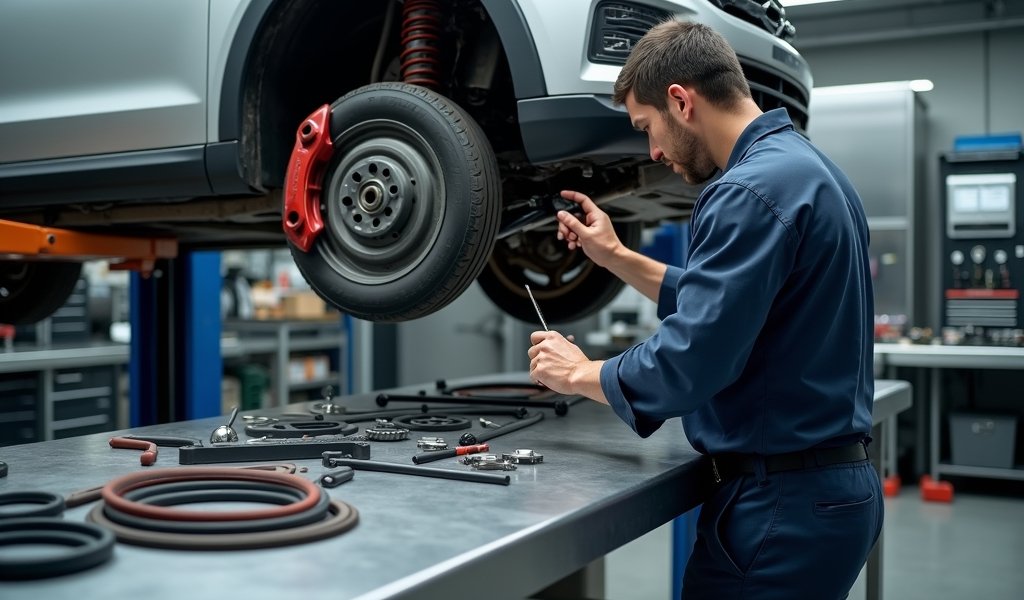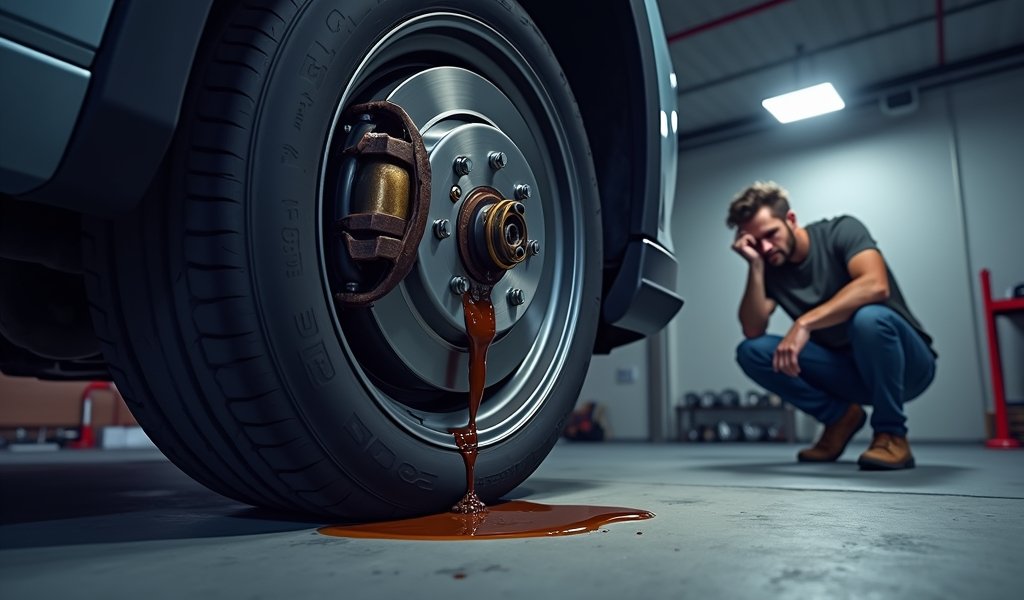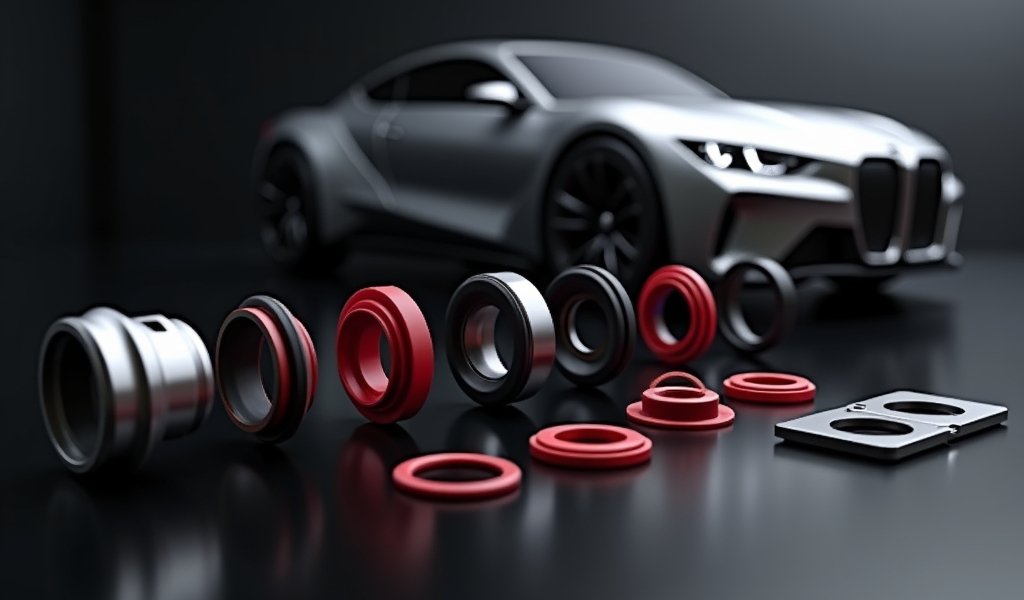Overview
This article examines five solutions for brake caliper piston seal issues, including complete seal replacement, caliper rebuilding, partial seal replacement, professional servicing, and full caliper replacement, with emphasis on identifying failure symptoms and preventative maintenance. The author, an experienced mechanic, provides detailed instructions and cost considerations for each approach while stressing the critical role these small components play in vehicle safety.
Table of Contents
- Understanding Brake Caliper Piston Seal Kits
- Signs of Failing Brake Caliper Seals
- Fix #1: Complete Seal Kit Replacement
- Fix #2: Caliper Rebuild Procedure
- Fix #3: Partial Seal Replacement
- Fix #4: Professional Caliper Service
- Fix #5: Caliper Replacement Alternative
- Preventative Maintenance
- Conclusion
- Frequently Asked Questions
Understanding Brake Caliper Piston Seal Kits
Your vehicle’s brake caliper piston seal kit is one of those unsung heroes of automotive safety that rarely gets the attention it deserves. As a mechanic who’s rebuilt hundreds of brake calipers over my 20+ year career, I can tell you these small rubber components play an outsized role in your vehicle’s stopping power. The brake caliper piston seal kit typically includes the piston seal, dust boot, and sometimes additional components like O-rings and bleeder valve caps.
These seals serve two critical functions. First, they create hydraulic pressure by preventing brake fluid from leaking past the piston. Second, they help retract the piston slightly when you release the brake pedal, preventing brake drag. When these seals fail, they can lead to serious braking issues that compromise your safety on the road.
Whether you’re a DIY enthusiast or just want to understand what your mechanic is talking about, knowing about brake caliper piston seal kits can save you time, money, and potentially prevent a brake failure. Today, we’ll dive into five proven fixes for common caliper seal issues that I’ve successfully used throughout my career.
Signs of Failing Brake Caliper Seals
Before jumping into repairs, it’s important to recognize when your brake caliper piston seal kit needs attention. Your vehicle will usually give you clear signals when these seals start to fail. Let’s review the most common symptoms:
- Brake fluid puddles beneath your vehicle (especially near the wheels)
- Spongy or soft brake pedal feel
- Uneven brake pad wear between the inner and outer pads
- Vehicle pulling to one side during braking
- Decreased braking performance or longer stopping distances
- Burning smell after driving (caused by dragging brakes)
One of the most telling signs is finding moisture around the caliper piston. If you notice a slick, oily substance on your caliper, that’s likely brake fluid that’s bypassed the piston seal. Don’t ignore this warning! Deteriorating brake pad compounds can also indicate caliper seal issues, as dragging can cause excessive heat and premature pad wear.
Remember, these symptoms could also indicate other brake system issues, but when several appear together, failing caliper seals are a prime suspect. Let’s explore how to address these problems effectively.

Fix #1: Complete Seal Kit Replacement
The most thorough solution for failing caliper seals is a complete brake caliper piston seal kit replacement. This approach addresses all potential seal issues in one service and provides the longest-lasting fix. I typically recommend this option for vehicles with over 70,000 miles or those showing multiple symptoms of seal failure.
To perform a complete seal kit replacement, you’ll need:
- The correct brake caliper piston seal kit for your specific make and model
- Brake fluid (DOT 3, 4, or 5.1 as specified by manufacturer)
- Brake caliper tool (for retracting and installing pistons)
- Brake cleaner spray
- Brake assembly lubricant
- Basic mechanics tool set
The process involves removing the caliper from the vehicle, disassembling it completely, cleaning all components thoroughly, and replacing all seals and boots. Professional mechanics recommend taking detailed photos during disassembly to ensure everything goes back together correctly.
A complete seal kit replacement typically takes 2-3 hours per axle for an experienced mechanic, though DIYers should allocate more time. The key advantage is reliability—by replacing all seals simultaneously, you eliminate the guesswork and prevent future failures. Just remember that this procedure requires a proper brake system bleed afterward to ensure no air remains in the lines.
Fix #2: Caliper Rebuild Procedure
A caliper rebuild goes beyond just replacing seals—it’s a comprehensive restoration of your brake caliper. This procedure is ideal for vehicles with significant caliper wear or corrosion, particularly those in regions with harsh winters where road salt accelerates deterioration.
When rebuilding a caliper, you’ll not only replace the brake caliper piston seal kit but also address other components that might affect performance. The process includes:
- Inspecting the caliper bore for scoring or corrosion
- Polishing or honing the bore if necessary
- Checking the piston for damage or pitting
- Replacing the bleeder valve if corroded
- Replacing or refurbishing the caliper slider pins and boots
- Testing the caliper for proper movement after reassembly
One crucial step that’s often overlooked is properly cleaning the piston and caliper bore. As automotive service experts explain, even minor contaminants can damage new seals. I recommend using a designated brake parts cleaner and lint-free cloths during this process.
The rebuilding process typically takes 3-4 hours per axle and requires more specialized tools than a basic seal replacement. However, it’s often more cost-effective than purchasing new calipers, especially for higher-end vehicles. Just make sure you have a clean, well-lit workspace before starting this project.
Fix #3: Partial Seal Replacement
In some situations, a full brake caliper piston seal kit replacement might not be necessary. If you’ve caught the problem early and only the dust boot is damaged—while the piston seal remains intact—a partial seal replacement can be a viable, time-saving solution.
The dust boot (sometimes called a dust seal) protects the piston and main seal from environmental contaminants like road grime, water, and salt. While it doesn’t contain hydraulic pressure, its role in preserving the main seal is crucial. When this component fails but the hydraulic seal is still functioning, replacing just the dust boot can be appropriate.
Here’s what the partial replacement process involves:
- Removing the caliper (but not necessarily taking it completely apart)
- Carefully removing the damaged dust boot without disturbing the main seal
- Cleaning the exposed areas thoroughly
- Installing the new dust boot
- Reinspecting the caliper for proper operation
This approach is significantly faster than a complete rebuild, often taking only 1-1.5 hours per caliper. However, it comes with an important caveat: the main piston seal must be in good condition. If you’re attempting this fix as a DIYer, remember that once you’ve exposed the internal components, it’s prudent to at least have a full seal kit on hand in case you discover more extensive damage than anticipated.
I’ve found this approach particularly useful for preventative maintenance on vehicles where I’ve noticed early dust boot deterioration during routine car service. By addressing this issue proactively, you can often extend the life of your entire braking system.

Fix #4: Professional Caliper Service
While many vehicle owners enjoy DIY projects, brake work is one area where professional service often makes sense. A professional caliper service for your brake caliper piston seal kit issues offers several advantages that might outweigh the higher cost.
When you bring your vehicle to a professional shop, you’ll benefit from:
- Expert diagnosis to identify the exact source of brake problems
- Access to specialized tools and equipment for proper caliper service
- OEM or high-quality aftermarket parts
- Complete system testing after service
- Warranty protection on both parts and labor
Professional technicians have the experience to spot issues that might not be obvious to even enthusiastic DIYers. For instance, they can identify when a caliper bore is too scored for reliable seal performance or when pistons have developed microscopic corrosion that would compromise a new seal.
The cost typically ranges from $150-$400 per axle for caliper rebuild services, depending on your vehicle and location. While this is more than a DIY approach, the peace of mind can be well worth it, especially considering the safety-critical nature of your braking system.
And don’t forget—we offer free brake inspections and quotes at our service centers located throughout the US, Europe, and Canada. Your local branch can be easily found using the geolocation feature on our company’s website. Our certified technicians can evaluate your brake system and provide expert recommendations tailored to your specific vehicle.
Fix #5: Caliper Replacement Alternative
Sometimes, the most economical and time-efficient solution isn’t rebuilding your calipers but replacing them entirely. This approach is particularly relevant for older vehicles or those with calipers that show significant wear beyond just seal issues.
When evaluating whether to rebuild or replace, consider these factors:
- Age and overall condition of the existing calipers
- Presence of pitting, scoring, or corrosion on pistons or bores
- Cost difference between quality seal kits and remanufactured calipers
- Your comfort level with complete disassembly and reassembly
- Available time for the repair
Remanufactured calipers come with new brake caliper piston seal kits already installed, along with refurbished or new pistons, hardware, and bleeder valves. These units typically cost between $50-$150 per caliper for most mainstream vehicles, making them competitive with buying individual components for a rebuild.
The replacement process is straightforward: remove the old caliper, install the new one, and bleed the brake system. This approach typically takes 1-2 hours per axle, significantly less than a complete rebuild. For DIYers with limited time or tools, this option offers the best balance of quality, cost, and convenience.
Just ensure you select quality remanufactured calipers from reputable brands. As noted in Motor Magazine’s industry analysis, there can be significant quality differences between economy and premium remanufactured units.
Preventative Maintenance
An ounce of prevention is worth a pound of cure—especially when it comes to brake caliper piston seal kits. Implementing a few simple maintenance practices can significantly extend the lifespan of your caliper seals and help you avoid costly repairs down the road.
Here are my top preventative maintenance recommendations:
- Regularly inspect brake fluid for contamination (it should be clear to amber, never dark brown)
- Change brake fluid every 2-3 years to prevent seal deterioration
- Clean and lubricate caliper slider pins during brake pad replacements
- Visually inspect dust boots for tears or cracks during routine maintenance
- Address minor leaks immediately before they cause seal failure
- Use the correct brake fluid type as specified by your vehicle manufacturer
Brake fluid hygroscopicity—its tendency to absorb moisture from the atmosphere—is a primary cause of seal degradation over time. This absorbed moisture lowers the fluid’s boiling point and can corrode internal components, including seals. Regular fluid changes prevent this moisture accumulation from reaching harmful levels.
When performing brake pad replacements, take the extra few minutes to inspect the caliper pistons and dust boots. Clean any visible debris and look for signs of fluid seepage around the piston. This simple step can help you catch early warning signs before they develop into major problems.
Remember, our locations across the US, Europe, and Canada offer free brake inspections that include evaluation of your caliper seal condition. Taking advantage of this service during routine maintenance can save you from unexpected brake failures and costly emergency repairs.
Conclusion
Your brake caliper piston seal kit may be small in size, but its impact on vehicle safety is enormous. Whether you choose a complete seal kit replacement, caliper rebuild, partial seal replacement, professional service, or full caliper replacement, addressing seal issues promptly is crucial for maintaining optimal braking performance.
Each approach we’ve discussed has its merits depending on your specific situation, mechanical skill level, and budget. For vehicles showing early signs of seal wear, a preventative dust boot replacement might be sufficient. For those with more extensive issues, a complete rebuild or replacement often provides the most reliable long-term solution.
Remember that your brake system is not an area to cut corners. Quality components and proper installation techniques are essential for safety. If you’re uncertain about tackling a brake caliper project yourself, our professional technicians are always available to help—with free inspections and quotes at our locations throughout the US, Europe, and Canada.
By understanding the options available for addressing brake caliper seal issues, you’re better equipped to make informed decisions about your vehicle’s maintenance. Your safety, and that of your passengers, depends on a properly functioning brake system—and that system relies heavily on those small but mighty caliper seals.
Frequently Asked Questions
How long do brake caliper seals typically last?
Brake caliper seals typically last between 5-7 years or 50,000-70,000 miles under normal driving conditions. Environmental factors like extreme temperatures or road salt can significantly shorten this lifespan.
Can I replace just the piston seal without changing the dust boot?
It’s not recommended to replace only the piston seal while leaving an old dust boot. The dust boot protects the new seal from contaminants, and replacing both components together ensures proper system longevity.
How much does a complete brake caliper piston seal kit cost?
Brake caliper piston seal kits typically cost between $10-$40 per caliper, depending on your vehicle make and model. Premium kits for high-performance vehicles can cost more.
Is it normal for brake calipers to leak slightly?
No, even minimal brake fluid leakage indicates seal failure that requires immediate attention. Any brake fluid leak compromises your braking system and should never be considered normal or acceptable.
Can worn brake caliper seals cause ABS light to come on?
Yes, failing caliper seals can cause uneven brake pressure or fluid level drops that trigger the ABS warning light. The ABS system monitors hydraulic pressure and will detect these abnormalities.

